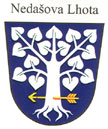Nedašova Lhota
| Nedašova Lhota | ||||
|---|---|---|---|---|
|
||||
| Basic data | ||||
| State : |
|
|||
| Region : | Zlínský kraj | |||
| District : | Zlín | |||
| Area : | 932 ha | |||
| Geographic location : | 49 ° 7 ' N , 18 ° 5' E | |||
| Height: | 450 m nm | |||
| Residents : | 689 (Jan 1, 2019) | |||
| Postal code : | 763 32 | |||
| License plate : | Z | |||
| traffic | ||||
| Street: | Brumov-Bylnice - Tuchyňa | |||
| structure | ||||
| Status: | local community | |||
| Districts: | 1 | |||
| administration | ||||
| Mayor : | Miroslav Fojtík (as of 2010) | |||
| Address: | Nedašova Lhota 10 763 32 Nedašov |
|||
| Municipality number: | 585548 | |||
| Website : | www.antee.cz/nedasovalhota/ | |||
Nedašova Lhota (German Nedaschowa Lhotta , 1939-1945 Nedasch Lhota ) is a municipality in the Czech Republic . It is located six kilometers northeast of Brumov-Bylnice and belongs to the Okres Zlín .
geography
Nedašova Lhota is located in the north of the White Carpathians in the area of the CHKO Bílé Karpaty Nature Park. The village extends on the border with Slovakia in the valley of the Nedašovka brook and its tributary Říčka. To the north rise the Černá hora (664 m), Maliník (572 m), Pasecké Lazy (645 m), Požár (791 m) and Končitá (817 m), in the northeast the Krivá Tuchyňa (711 m) and Hromádková (761 m) ), east the Vysočká (659 m), Strošov (893 m) and Kobylinec (911 m), in the southeast the Kaňúr (791 m) and Kosák (766 m), south the Průklesy (835 m), Holý vrch (830 m) ) and Kršlisko (732 m) and in the west the Vrchy (632 m) and Polomy (659 m).
Neighboring towns are Študlov , Měřička and Radosin in the north, Paseky, Zápechová, Majere and Zubák in the Northeast, Nebrová and Lednica the east, Trokanovo and Cerveny Kamen in the Southeast, Lapač, Přítěž, Na Salaši, Na Kopanicách, Dúbrava and Nedašov in the south, Stráně and Návojná in the southwest, Vlčí Potok and Na Podskalí in the west and Valašské Klobouky , Poteč and Valašské Příkazy in the northwest.
history
The first written mention of the village took place in 1503 in the land table , when King Vladislav II Jagiello confirmed the redemption of the lordship of Brumov pledged to Jan von Lomnitz by the brothers Michal and Štěpán Podmanický from Podmanín. In 1520 Jan von Lomnitz acquired the rule from Michal Podmanický. After the death of Jaroslav von Lomnitz in 1572, his sister Magdalena inherited the rule. She was the wife of Henry III. von Münsterberg and sold the Brumov Castle with all its accessories in 1574 to Zdeněk Říčanský Kavka from Říčany. The Kavka von Říčany held the property until 1622, after which Paul Apponyi de Nagy-Appony Brumov acquired. Between 1626 and 1662 the rule belonged to Nikolaus and Esther Forgács. In the second half of the 17th century, the rule began to be divided among several owners. In 1731 the rule was divided into three. This Nedašova Lhota came to the First Rulership (Brumov I), whose owners were the Counts Illyesházy, who had shares in the rule since 1662. In 1758 the village consisted of 58 houses. In 1790 Nedašova Lhota had about 400 inhabitants. There is evidence of a school since 1820, in which an assistant teacher from Brumov taught. In 1834 530 people lived in the 71 houses in the village. The Count Illyesházy held Brumov I until 1835, after which Georg Simon von Sina bought the property.
After the abolition of patrimonial Nedašová Lhota / Nedaschowa Lhotta formed from 1850 a municipality in the district administration Uherský Brod . In 1868 a school house was inaugurated. The property was owned by Simon von Sina from 1856 to 1876 , and then by his daughter Josepha Iphigenie until 1894. She was followed by Anton Dreher until 1921 . In a big fire in 1895 40 houses, including the school, were destroyed. In 1901 another fire destroyed six wooden houses. In 1920 the village had about 500 inhabitants. In 1922 the community built a poor house in the Paseky settlement. After the death of Dreher's grandson and universal heir Oskar, the goods fell to his mother Edeltruda in 1926, who owned them until they were expropriated in 1945. In 1933 the Nebrová forest cooperative was established, which was affiliated to the noble Nebrová forest estate belonging to Edeltruda Countess Rainer-Harbach. Since 1949 Nedašova Lhota was assigned to the Okres Valašské Klobouky. In 1950 there were 760 people living in the village. At the end of 1960, the municipality came to Okres Gottwaldov after the Okres Valašské Klobouky was abolished . In 1976 Nedašova Lhota was merged with Nedašov and Návojná to form a municipality Nedašov-Návojná. This dissolved in 1992, and since then Nedašova Lhota has formed its own municipality again. After the dissolution of Czechoslovakia , Nedašova Lhota became a border town with Slovakia at the beginning of 1993.
The local volunteer fire brigade owns a four-wheeled handheld fire sprayer from 1902.
Community structure
No districts are designated for the municipality of Nedašova Lhota. To Nedašova Lhota belongs the settlement Paseky ( Paseke ).
Attractions
- Timbered Wallachian bell tower from 1867
- Homestead No. 38, timbered house and barn in Wallachian style
- Timbered chalup No. 105
- Stone bell tower, built in 1933
- Statue of St. John of Nepomuk, in front of the stone bell tower
- Stone cross in the lower village, consecrated in 1894
- Memorial to the victims of the First World War, in front of the kindergarten, erected in 1937

